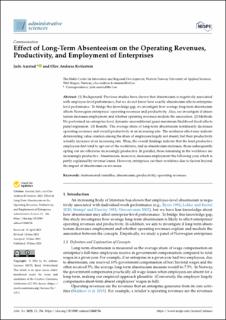| dc.description.abstract | Background: Previous studies have shown that absenteeism is negatively associated with employee-level performance, but we do not know how exactly absenteeism affects enterprise-level performance. To bridge this knowledge gap, we investigate how average long-term absenteeism affects Norwegian enterprises’ operating revenues and productivity. Also, we investigate if absenteeism decreases employment and whether operating revenues mediate the association. (2) Methods: We performed an enterprise-level dynamic unconditional quasi-maximum likelihood fixed-effects panel regression. (3) Results: The average share of long-term absenteeism nonlinearly decreases operating revenues and overall productivity at an increasing rate. The nonlinear effect may indicate deteriorating value creation among the share of employees largely not absent, but their productivity actually increases at an increasing rate. Thus, the overall findings indicate that the least productive employees first tend to opt out of the workforce, and as absenteeism increases, those subsequently opting out are otherwise increasingly productive. In parallel, those remaining in the workforce are increasingly productive. Absenteeism, moreover, decreases employment the following year, which is partly explained by revenue losses. However, enterprises cut their workforce due to factors beyond the impact of absenteeism on revenues. | en_US |

